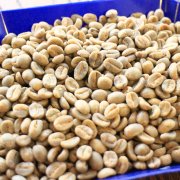Italian bikini with coffee slimming coffee espresso with beans
The blend of several coffees has the unique taste of deep roasting, good taste, and appropriate acidity.
1. 40%"whole city" roasted Colombia Tuluni coffee-for better taste (other Colombia coffees, La Illusion in Nicaragua, or Monte Carmelo coffee in Brazil)
30% French-Roasted Mexican Tres Flechas Coffee-forms a clear, charred flavor (can also be other Mexican coffee)
30% City-Roasted Kenyan Estate Coffee-Creates a bright sour flavor (it can also be a refreshing Costa Rican coffee, or other Central American coffee)[If you want to create a unique "Viennese coffee" with a good taste, a good sweet and bitter flavor, but still sour, but without the charred flavor, you can try the following blend:
IV. 60% of "citywide" roasted Colombia coffee
5.40% of urban roasted Kenyan coffee, or bright Central American coffee, using balanced, moderately sour, good-tasting Central American coffee, but also different degrees of roasting of the same coffee mix together;
VI. 60% city-wide roasted Colombia Tuluni, or Nicaragua La Illusion coffee, etc.
7.40% of city-roasted coffee is the same (roasted to the end of the first explosion)
Our exhibition is a great place to sample common coffee blends, and roasters bring their best coffee blends here for everyone to taste. At the American Specialty Coffee Association exhibition in 1998, there were many "Viennese coffee" blends that used 30% to 40% Kenyan coffee to emphasize their acidic taste. This blend improves the acidity of the coffee and makes it taste much better than Kenyan coffee.
Drip coffee blend: mocha-java coffee, one can't help but think, blend coffee and home coffee as old. The combination of a thick, average quality java with a moderate, fruity, more acidic mocha was the only two coffees available at the time. Is mixing these two coffees just a habit? Or is it because this combination improves their taste? In any case, the combination of these two coffees can make a coffee drink that tastes richer than either. Even with the simple coffee roasting and making tools of the time, it was incredible that such a rich blend of mocha and java could be made. It is not difficult to make a good coffee from two very good coffees. Commercially, coffee blending is to make a coffee beverage that tastes quite good from several coffee of poor quality. The original "mocha java" coffee is a blend of yemeni mocha coffee and indonesian java coffee. But it is also possible to use any Indonesian coffee, blended with any Ethiopian or Yemeni coffee. The usual blend ratio is one-to-one, or Indonesia has slightly more beans, such as 55:45. One of the best things we've done is we've done it with Hirazi or Dhamari beans from Yemen (or Ethiopian "Hara" beans) and Batak Mandheling or Sulawesi Toraja from Sumatra.
Espresso blends My personal favorites Decaf coffee blends If you need decaf espresso, prepare some water-processed Brazilian decaf beans. Use 50% of this coffee beans, plus some other coffee beans with different flavors. If you want coffee that's almost decaffeinated, choose one of these blends: 50% Brazilian water-processed decaf beans, 50% water-processed Sumatra decaf beans;50% Brazilian water-processed decaf beans, 25% Mexican Esmeralda decaf beans, 25% water-processed Sumatra decaf beans; We also have two kinds of blended espresso beans that customers can roast themselves. Ethiopian decaf beans are also great for making espresso. Try a blend of 50% water-processed Sumatra decaf beans and 50% Ethiopian decaf beans.
Caffa Coffee Note: We are here to introduce coffee blending is not to advocate that everyone go to their own coffee blending, just to introduce knowledge and general concepts. This doesn't help you mix your own coffee, it just gives you an idea. Because the organic structure of coffee is very complex, its blending is similar to Chinese traditional medicine, and it is difficult to complete it well without enough experience. Therefore, we do not advocate that everyone engage in coffee blending. It is best left to experienced Italian traditional coffee companies to do the job. It is also important to distinguish between "traditional" coffee businesses and "new" coffee businesses. As Italian coffee has become popular all over the world, many companies and individuals who did not have a technical basis in coffee processing are now processing italian coffee. But their products are hard to compare with the original enterprise products. Most of them use the name "Italian coffee"

Important Notice :
前街咖啡 FrontStreet Coffee has moved to new addredd:
FrontStreet Coffee Address: 315,Donghua East Road,GuangZhou
Tel:020 38364473
- Prev

The choice of novice coffee maker espresso blending ratio
First of all, we have to see what the purpose of Espresso coffee is. We say that if any kind of coffee appears in the form of a single product, it has the characteristics, that is, it has both advantages and limitations in taste. The purpose of the combination of Espresso is to express the taste of the baker. In other words, the taste of Espresso coffee is designed by the roaster. In order to make
- Next

Blend coffee Italian style mix beans concentrated latte to beat milk foam
The main commercial purpose of blending coffee is to reduce costs and mix coffee with coffee that is not very good. In order to improve sales profits. There is also a possible purpose, that is to put together a unique taste, the unique taste of a brand. Customers who like this taste have no choice but to buy it from this factory instead of supplying it from other suppliers.
Related
- Beginners will see the "Coffee pull flower" guide!
- What is the difference between ice blog purified milk and ordinary milk coffee?
- Why is the Philippines the largest producer of crops in Liberia?
- For coffee extraction, should the fine powder be retained?
- How does extracted espresso fill pressed powder? How much strength does it take to press the powder?
- How to make jasmine cold extract coffee? Is the jasmine + latte good?
- Will this little toy really make the coffee taste better? How does Lily Drip affect coffee extraction?
- Will the action of slapping the filter cup also affect coffee extraction?
- What's the difference between powder-to-water ratio and powder-to-liquid ratio?
- What is the Ethiopian local species? What does it have to do with Heirloom native species?

